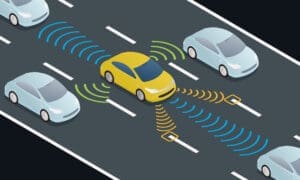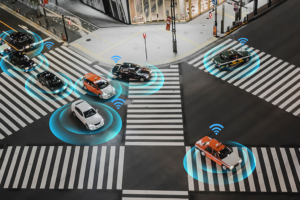
Vehicle-to-Vehicle (V2V) communication systems are revolutionizing road safety, especially in the freight, trucking, and logistics industry. These systems enable vehicles to share real-time information about speed, position, and trajectory, allowing them to anticipate and respond to potential hazards more effectively than human drivers alone. Let’s explore the mechanics, benefits, challenges, and prospects of V2V communication systems in the logistics sector.
Mechanics of V2V Communication Systems
V2V communication operates using dedicated short-range communications (DSRC) or cellular vehicle-to-everything (C-V2X) technology. These systems have a range of approximately three hundred meters and facilitate the exchange of critical data between vehicles. Here’s how it works:
Data Transmission: Vehicles continuously broadcast data, including position, speed, heading, brake status and many more operational parameters. This creates a network of interconnected vehicles sharing essential information with low latency.
Processing and Analysis: Each vehicle processes received data to assess potential collision risks. Advanced algorithms determine the need for actions such as braking or lane changes.
Alerts and Autonomous Actions: Upon detecting a potential hazard, the system alerts the driver and may autonomously take corrective actions, such as braking or steering, to avoid a collision.

 Benefits of V2V Communication Systems
Benefits of V2V Communication Systems
Collision Avoidance: V2V communication significantly enhances collision avoidance capabilities. Real-time data exchange allows vehicles to react swiftly to hazards. For example, if a vehicle ahead brakes suddenly, the following vehicle receives an instant alert, enabling timely braking and preventing rear-end collisions. The U.S. Department of Transportation indicates that V2V technology could prevent up to 80% of crashes involving unimpaired drivers, including rear-end, intersection, and lane-change collisions.
Enhanced Situational Awareness: V2V communication extends drivers’ situational awareness beyond their line of sight. Information about vehicles approaching from around a curve or over a hill helps drivers make informed decisions, enhancing overall safety.
Reduced Traffic Congestion: By enabling vehicles to coordinate movements, V2V technology can mitigate traffic congestion. Harmonized speed adjustments reduce stop-and-go traffic, improving fuel efficiency and decreasing emissions.
Improved Emergency Response: In an accident, V2V-enabled vehicles can immediately communicate incident details to nearby vehicles and emergency responders, helping prevent secondary collisions and expedite emergency response times.
Challenges of V2V Communication Systems
Standardization and Interoperability: Achieving seamless communication between vehicles from different manufacturers requires industry-wide standards and cooperation. The Society of Automotive Engineers (SAE), the USDOT and other SDOs continue to develop standardized protocols for V2V communication, but universal adoption remains a complex challenge. For more information on these efforts, read more here: https://www.its.dot.gov/factsheets/pdf/ITSJPO_Connected_Vehicle_Standards.pdf
Data Privacy and Security: The exchange of real-time data raises significant privacy and security concerns. Robust encryption and authentication mechanisms are crucial to protect data integrity and confidentiality. Regulatory frameworks must govern the use and sharing of V2V data to gain public trust and ensure widespread adoption.
Infrastructure and Investment: Implementing V2V communication requires significant investment in vehicle technology and supporting infrastructure, including roadside units (RSUs) for V2I communication. Upgrading existing fleets and infrastructure can be cost-prohibitive, particularly for smaller companies. Government incentives and public-private partnerships are necessary to accelerate adoption.
Regulatory and Legal Issues: Deploying V2V communication systems involves navigating complex regulatory and legal landscapes. Policymakers must address liability, data ownership, and safety compliance issues to create a cohesive regulatory framework that balances innovation with public safety.
Prospects of V2V Communication Systems
Integration with Autonomous Vehicles: V2V communication is also vital for autonomous vehicles, enhancing their safety and reliability. Autonomous trucks with V2V communication can operate efficiently in convoys or platoons, reducing fuel consumption and increasing road capacity. Companies like Tesla and Waymo are integrating V2V technology with their autonomous platforms, positioning themselves at the forefront of logistics innovation.
Expansion of V2I and V2X Communication: The future will see an expansion to include Vehicle-to-Infrastructure (V2I) and Vehicle-to-Everything (V2X) communication, enabling interactions with traffic signals, road signs, and pedestrians. Smart infrastructure, such as connected traffic lights and road sensors, will further enhance V2V capabilities, improving traffic management and safety.
Enhanced Data Analytics and Machine Learning: The vast data generated by V2V systems provides valuable insights for improving transportation safety and efficiency. Advanced analytics and machine learning can identify patterns, predict hazards, and optimize traffic flow. Logistics companies can use these insights to enhance fleet management, reduce operational costs, and improve service reliability. Real-time data analysis supports proactive maintenance, minimizing vehicle downtime and extending component lifespan.
Policy and Collaboration: Successful V2V implementation requires collaboration between industry stakeholders, government agencies, and technology providers. Policymakers must create a regulatory environment that encourages innovation while ensuring public safety. Public-private partnerships and international cooperation will be essential to developing standardized protocols, addressing privacy concerns, and securing necessary investments.
Summing Up
Vehicle-to-Vehicle (V2V) communication systems are a transformative advancement in the freight, trucking, and logistics industry. These systems enhance safety, reduce accidents, and improve traffic efficiency through real-time data exchange between vehicles. Despite challenges in standardization, privacy, and investment, the prospects of V2V communication are promising.
For senior leaders in the logistics industry, understanding and investing in V2V technology is crucial. Integrating V2V communication with autonomous vehicles, smart infrastructure, and advanced data analytics will drive further innovations. Embracing these advancements and fostering collaboration will create a safer, more efficient, and sustainable transportation ecosystem, positioning your organization at the forefront of the logistics revolution.


Jim Frazer is a cross-disciplinary leader with over three decades of experience in technology development, deployment, and operations management. With a deep focus on competitive business intelligence and marketing communications, Jim has a proven track record of guiding organizations through transformative business model shifts. As a high technology corporate strategist, he excels at innovative problem-solving through integrated strategic, technical, and fiscal business models.




















